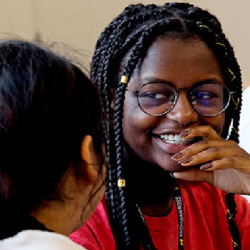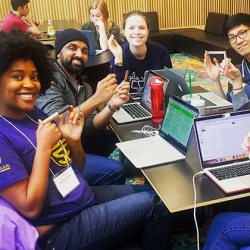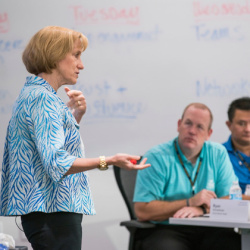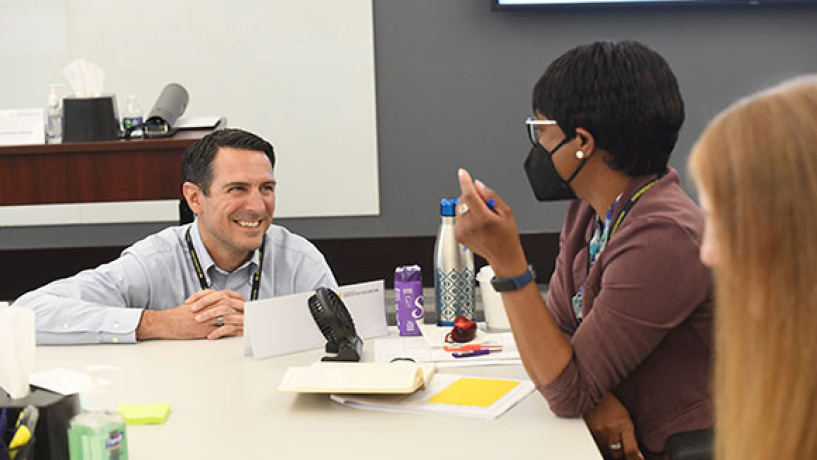Leading Organizational Transformation with Positive Leadership
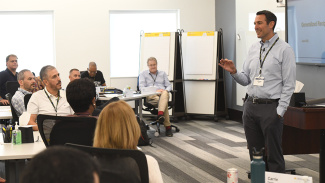
Today's business leaders face a tough task when challenging the prevailing practices and norms of their organizations, but it's a necessary step for genuine organizational transformation.
So, what can leaders do to influence the changes needed? Shawn Quinn, Executive Education faculty at Michigan Ross, illuminates the path forward through the lens of positive leadership in this interview, explaining its role and relevancy in recent years of uncertainty and what learners can expect in the executive education program.
How would you define positive leadership?
There are a lot of different ways to think about positive leadership. The one way I think about it is that there are a number of normalized assumptions that shape organizational life, including the way leaders choose to interact with the organization, whether it's the processes they put in place or their behavior. When the Center for Positive Organizations formed here at the University of Michigan, they asked, “What does the leader, team, or organization look like when it’s at its best?”.
This unique approach gave way to a new set of assumptions. We found that when you study people when they are at their best, you see something different—people are contributing, sacrificing for the common good, more transparent, more authentic—the list goes on. So, a positive leader is one who believes in assumptions that give rise to excellence.
Many people often say they want excellence, so another term I often think about instead is positive deviance. You can deviate from organizational norms in a positive or a negative way. But, anytime you step outside the norms of the existing cultures and practices, it’s uncomfortable, it can be lonely, and it can be challenging. That’s why leadership is hard.
Are there misconceptions about positive leadership?
Positive leadership is focused on the practice of Positive Organizational Scholarship. So sometimes people hear the term Positive Leadership, and they assume that it simply means being upbeat or friendly, but there's actually much more to the theory. The executive education program at Michigan Ross focuses on how leaders can implement the theory to improve the performance of their organization.
On the other hand, when you think about positive assumptions and positive deviance, I think there’s much more to the understanding of the word positive than where people’s minds go right away, like saying nice things. Not that that’s not part of it, but it’s really about a sufficient understanding.
When you help people clarify who they are at their best, and when they see what other people value about them, it gives them greater capacity to enter things they are not good at or uncertain about because they know they are valued.
What role does positive leadership play in leading organizations through change and uncertain times, as many organizations have experienced greatly in recent years?
We all have certain beliefs, and because of our beliefs, we behave in certain ways. We can teach a tool or a concept and have someone go back and apply it for a while, but under stress or pressure, we often revert back to our starting beliefs and what we know. When faced with uncertainty, leaders often exhibit more control, depending on their beliefs. We know less about what is going to create success when dealing with uncertainty, so we need the workforce to be more creative and engaged. But the more we try to control, the less they feel like they can share ideas or innovate to learn our way through uncertainty.
Part of what positive leadership is trying to do is help leaders first manage and stabilize themselves to deal with change and uncertainty. There is a lot of mental and emotional work on how to do that, as well as being open to learning, growth, and change. Another part of it is when you help people clarify who they are at their best, and when they see what other people value about them, it gives them greater capacity to enter things they are not good at or uncertain about because they know they are valued.
As the faculty director for the Michigan Ross Executive Education program, The Positive Leader: Deep Change and Organizational Transformation, in your opinion, why is this program relevant for business leaders today?
I have had the opportunity to work with people from all over the world, including groups in Asia, Africa, Europe, and the US, and there is something that I see everywhere I go: organizations are full of victims. Most people would not call themselves victims, but people have real data that tells them why they can’t do more than what they are doing. Whether it's ‘if I do this, it upsets that person,’ or ‘this silo shuts me down and doesn’t share information,’ it can be bad. But then we become victims; we stop trying to push boundaries and do things differently in a way that helps us achieve what we all say we want.
People benefit from this program because it helps them begin to clarify and understand what they can do to step outside the norms and the justifications they have that block them from leading. It’s easy to say you want excellence, and it’s easy to say that you are a leader. But we all know people who are in leadership roles and aren’t leading, and the opposite also exists. So I often ask program participants, “If you no longer had your formal position, would the people under you still follow you?” and “How would you approach them differently if you wanted them to follow you, regardless of position in the hierarchy?”
We all need help freeing ourselves up at times to do what we need to do to lead in our organizations. I really believe that by the end of the week in this learning journey, we set the participants free to get out of their own way and start to try leading again, whether that’s with their team, their boss, or their peers; we see people go try pretty amazing things that they admit they would not have done before.
Can you give us a preview of some of the lessons that participants experience in this program?
One of the framing pieces we explore in this program is abundance gaps, which Professor Kim Cameron spends time on. Abundance gaps unleash the heliotropic effect, which he defines as “the tendency in all living systems toward that which gives life and away from that which depletes life—toward positive energy and away from negative energy.” Abundance gaps look at the gaps between normal and excellence instead of normal and problems, which is still essential to address, but the issue is that many organizations spend most of their time there. Professor Cameron also discusses positive energizers and helps participants see what they can do to become an energizer, introducing that it’s not a trait you are born with but something that anyone can learn.
Another framework we introduce to the participants in the program is about high-quality connections with Professor Jane Dutton. Professor Dutton found that you could have the best strategy in the world, but if the people in the organization weren’t interacting in ways that built the capacity to deliver that strategy, then it didn’t matter how good the strategy was. So, she studied interactions that leave people highly energized instead of normal interactions that leave both people feeling the same, and she helps the participants to understand how to create more of these energized, high-quality interactions and connections and the capacities they build within their teams.
Can you tell us more about the personal case projects in this program?
We invite program participants to write a 4-page case before the program or, in some instances, during the program because the content learned might change their thoughts and what they want to work on. The case should be kept to the idea of some situation dealing with people; it could be a problem they are dealing with or an opportunity for excellence. Participants get to choose whatever is meaningful to them.
On the night before the last day of the program, participants in groups of 4 or 5 read all of the cases from their group. The next day, they take turns focusing on one individual’s case, where they have a chance to answer any questions about their case to their group. Then, that individual exits the room while the rest of the group takes around 30 minutes to brainstorm how to best help this individual using the content they learned, with a coach also in the room to observe and help push their thinking when needed. The brainstorming session isn’t about telling the individual what they should do, but rather, it’s about providing good and challenging questions for them to consider and ideas that ultimately lead to the individual reaching their own solution. The process takes around an hour, and then they rotate to the next individual.
Participants find the case projects to be highly valuable because they’ve learned the content intellectually, they’ve done exercises throughout the week, and now they are around the real situations they are all dealing with and having to figure out what it looks like when they apply the content to their day to day. So, by the end of the program, they’ve had multiple levels of experiences to prepare them before they go back and now try to interact with these situations differently.
What else makes this program unique?
Sixty days after the program ends, the same groups from the case projects, along with their coaches, meet for an hour to not only hold each other accountable but also share some of their successes. Because what one participant tried is different than what another participant tried, sharing those ideas and asking questions can remind the participants of what they learned and could give ideas for new things to try. This follow-up to provide an assurance of learning is just one example of the many unique things we do in this program.
Discover new insights, perspectives, and practices to influence the changes needed in your organization's culture with “The Positive Leader: Deep Change and Organizational Transformation.”
